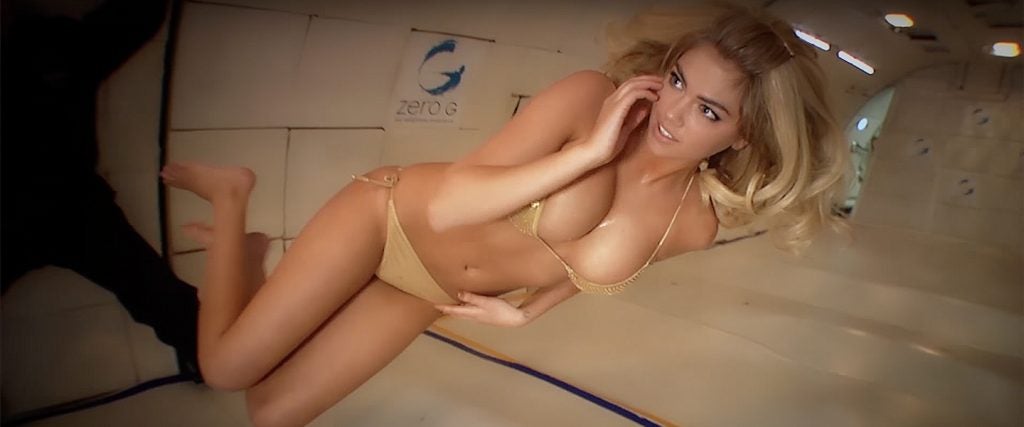Big naturals are more than just a body part. They’re an energy, a culture, a lens through which we consume and create the world around us. And while big-breastedness may be both spiritual and bodily, there is a material world and timeline of events that document how this culture came to be. As MEL’s resident boob culture writer and a woman of breast-experience, I’ll be analyzing these objects and happenings, telling the stories of their origins and their impact on society. This is Big Moments in Big Naturals.
Despite the eternal timelessness of breasts, our culture is constantly looking for new ways to push them forward. Put boobs into any situation they haven’t been seen before, and the gimmick does not wear thin. Such was the premise of the infamous February 2014 Sports Illustrated cover featuring Kate Upton’s gravity-defying bikini shoot. Sure, just showing Upton on a beach in a swimsuit would have been enough, but on this occasion, for whatever reason, Sports Illustrated decided to tweak the formula, catapulting Upton skyward into zero-gravity with the tacit goal of exploring whether her breasts would remain as awe-inspiring as they were on the ground. (They did not disappoint.)
But despite appearing as though Upton was shot into space, that isn’t quite what happened. Instead, SI sent her up into a modified Boeing 727 offered by the company ZERO-G, which flew the plane in parabolic arcs, yielding momentary spurts of weightlessness. According to Space.com, pilots tilted the plane during the downward slope of the parabola 13 times, each of which delivered 30 seconds of “zero gravity.” It’s an experience that anyone can pay to have through ZERO-G, which offers flights at various locations throughout the year, for the price of $8,500 a person. It’s unclear exactly how much Sports Illustrated paid to conduct the shoot, but presumably, it had a heftier price tag than their usual beach locales.
At the time, the 21-year-old Upton was the model of the moment. Bizarrely, though, her body was also a contested political site in pop culture. Upon her rise to fame in 2012 with her first Sports Illustrated cover, there was feverish debate about whether she could be considered “fat” by model standards. Admittedly pro-anorexia blog SkinnyGossip described her as having “huge thighs, NO waist, big, fat floppy boobs, terrible body definition — she looks like a squishy brick. Is this what American women are ‘striving’ for now? The lazy, lardy look? Have we really gotten so fat in this country that Kate is the best we can aim for? Sorry, but eww!”
Naturally, much of the conversation surrounding this centered on the absurdity of criticizing Upton’s body at all. But the fact that so many sites (Jezebel, Shape, Salon, etc.) even considered defending Upton — rather than simply brushing off the blog as the writings of a clearly ill person — points to the reality that she did have a body type different from other models of the early 2010s. And while that horrid blogger is wrong about most of Upton’s body, she does get one thing right: Upton does indeed have “big fat” boobs. And thank god for that.
As Vogue pointed out in a 2013 cover story about Upton, her breasts are a central part of her claim to fame. “Descriptions of her figure tend to involve euphemisms for a single word: breasts,” they wrote. And so, by sending Upton into “space” to capture her in zero gravity, Sports Illustrated demonstrated (at least in part) a commitment to these breasts specifically. Zero gravity would have been novelty enough, but by choosing Upton for the role, the shoot demonstrated the versatility and invariable appeal of a great set of big naturals. It also flipped the controversy on its head, making Upton literally weightless at a time when everyone was talking about her weight, a conscious move that stoked the conversation further. Even so, her floating around inside an aircraft is almost secondary — it’s her beauty and her breasts that take precedence.
For her part, Upton at least seemed to enjoy it. “In my experience with Sports Illustrated, it’s about the adventure,” Upton said in a clip of the shoot. “When I get that call from them, I’m ready to say yes.” She elaborated further for E! News Now, saying, “It was one of my favorite experiences so far in my life. You have no control over your limbs and you’re twirling; you don’t know what’s the ceiling and what’s the floor and it’s a really cool feeling.”
This wasn’t the first time Sports Illustrated tested a new concept with Upton, either. In a prior shoot for the magazine, she became the first model to pose in Antarctica. She suffered frostbite and temporary, partial vision and hearing loss in the process. But like the space shoot, the Antarctica photos further demonstrate that big boobs appeal to viewers in nearly any context, and the strange controversies surrounding her body further illuminates the role that her bodaciousness played in making these shoots famous.
SI could have selected any model, perhaps one less endowed, to set off to Antarctica or test out weightlessness. Instead they chose the bosomous Upton, someone whose body had been criticized due to its presence in Sports Illustrated itself. Obviously, Upton is an extremely conventionally attractive white, tall, thin blonde, and it wasn’t that radical of a decision to make her a star. But despite that, all the criticism situates the event firmly in the early 2010s. Only eight years later, we can look back upon both the Antarctica and zero-gravity shoots blissfully unaware of the circumstances or reality of their implementation. Instead, all there really is to do is admire.

